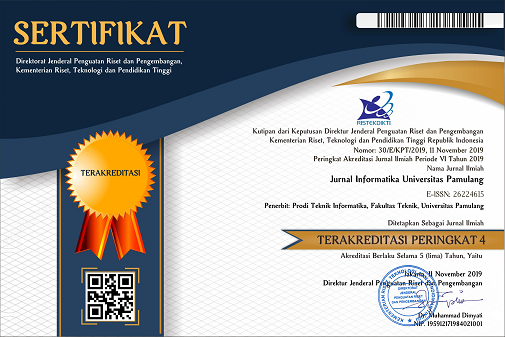Klasterisasi Pengunjung Mall untuk Menentukan Target Pasar Ponsel Terbaru Menggunakan Algoritma K-Means Clustering
DOI:
https://doi.org/10.32493/informatika.v6i3.11629Keywords:
K-means, Analysis, Cellphone, People, ClustersAbstract
Every day there are always people who visit the mall with different needs, there are some people who visit the mall to buy cell phones that have the latest features to make them look more updated, some just look around and some are not recommend to buy a new one because he still thinks his phone can still be used. To overcome this, electronic goods sales shops, especially those selling cellphones, need an analysis when they want to sell the latest products. They can group those people with expenditure information and their stages using the Kmeans Clustering algorithm. The results of these people will be divided into several clusters, namely people who will buy, people who might buy or people who will not buy, so when these cellphone distributors want to sell the latest cellphones, they will know how many people have the opportunity to buy the cellphone.References
Arofah, S. N., & Marisa, F. (2018, Mei). Penerapan Data Mining untuk Mengetahui Minat Siswa pada Pelajaran Matematika menggunakan Metode K-Means Clustering. JOINTECS (Journal of Information Technology and Computer Science), 3(2), 85-90. doi:10.31328/jointecs.v3i2.787
Fathia, A. N., Rahmawati, R., & Tarno. (2016). Analisis Klaster Kecamatan di Kabupaten Semarang Berdasarkan Potensi Desa Menggunakan Metode Ward dan Single Linkage. Jurnal Gaussian, 5(4), 801-810. doi:10.14710/j.gauss.v5i4.17109
Matplotlib development team. (2021, August 30). matplotlib.pyplot.bar. Retrieved from Matplotlib: https://matplotlib.org/stable/api/_as_gen/matplotlib.pyplot.bar.html
Nishom, M. (2019). Perbandingan Akurasi Euclidean Distance, Minkowski Distance, dan Manhattan Distance pada Algoritma K-Means Clustering berbasis Chi-Square. JPIT (Jurnal Informatika: Jurnal Pengembangan IT), 4(1), 20-24. doi:10.30591/jpit.v4i1.1253
Retno, S. (2019, Juli 8). Peningkatan Akurasi Algoritma K-Means dengan Clustering Purity Sebagai Titik Pusat Cluster Awal (Centroid). Medan: Universitas Sumatera Utara.
Sardar, T. H., & Ansari, Z. (2018). An Analysis of MapReduce Efficiency in Document Clustering Using Parallel K-means. Future Computing and Informatics Journal, 3(2), 200-209. doi:10.1016/j.fcij.2018.03.003
scikit-learn developers (BSD License). (2021, August 30). sklearn.cluster.KMeans. Retrieved from scikit-learn: https://scikit-learn.org/stable/modules/generated/sklearn.cluster.KMeans.html
Waskom, M. (2021, August 30). seaborn.scatterplot. Retrieved from Seaborn: https://seaborn.pydata.org/generated/seaborn.scatterplot.html
Downloads
Published
Issue
Section
License
Authors who publish with this journal agree to the following terms:
- Authors retain copyright and grant the journal right of first publication with the work simultaneously licensed under a Creative Commons Attribution-NonCommercial 4.0 International (CC BY-NC 4.0) that allows others to share the work with an acknowledgement of the work's authorship and initial publication in this journal.
- Authors are able to enter into separate, additional contractual arrangements for the non-exclusive distribution of the journal's published version of the work (e.g., post it to an institutional repository or publish it in a book), with an acknowledgement of its initial publication in this journal.
- Authors are permitted and encouraged to post their work online (e.g., in institutional repositories or on their website) prior to and during the submission process, as it can lead to productive exchanges, as well as earlier and greater citation of published work (See The Effect of Open Access).
Jurnal Informatika Universitas Pamulang have CC-BY-NC or an equivalent license as the optimal license for the publication, distribution, use, and reuse of scholarly work.
In developing strategy and setting priorities, Jurnal Informatika Universitas Pamulang recognize that free access is better than priced access, libre access is better than free access, and libre under CC-BY-NC or the equivalent is better than libre under more restrictive open licenses. We should achieve what we can when we can. We should not delay achieving free in order to achieve libre, and we should not stop with free when we can achieve libre.
Jurnal Informatika Universitas Pamulang is licensed under a Creative Commons Attribution-NonCommercial 4.0 International (CC BY-NC 4.0)
YOU ARE FREE TO:
- Share : copy and redistribute the material in any medium or format
- Adapt : remix, transform, and build upon the material for any purpose, even commercially.
- The licensor cannot revoke these freedoms as long as you follow the license terms





